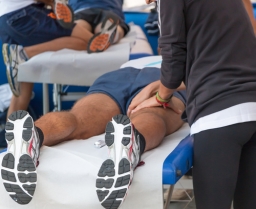What is the role of physical therapy in sport?
Wednesday, January 18, 2017 - 09:00

Most active Canadians will at some point in their life experience an injury related to their physical activity or sport. Knowing what to do and how to address these injuries so they don’t get worse is where sport physiotherapy comes into play. While many small injuries can be treated by a family doctor, quite often these and more complex injuries are referred to a physiotherapist. A physiotherapist is a recognized professional that has been trained in human anatomy, movement and pain management techniques. In Canada, a sport physiotherapist is a physiotherapist who has completed the Diploma in Sport Physiotherapy through Sport Physiotherapy Canada which gives them experience in the care of athletes at all levels as well as physically active individuals.
A sport physiotherapist is a specialist who is trained in the prevention and management of injuries sustained through sport and exercise by developing, maintaining and restoring maximum movement and functional ability in their patients. Their three main focuses are: preventing injury, restoring optimal function, and contributing to enhancing sport performance.
- Prevention: This includes a focus on risk management around potential injury. Knowing an athlete’s sport and medical history helps the therapist design strategies to reduce the risk of injury.
- Injury or Illness Recovery: This involves a clinical evaluation, diagnosis and treatment plan integrating the goals of the athlete in terms of performance. Strategies around returning the athlete to optimal performance are coordinated with minimizing the risk of re-injury.
- Enhancing Performance: A sport physiotherapist can be part of the athlete’s support team in helping to develop strategies to enhance an athlete’s physical capacity through their knowledge of efficient movement technique.
- Advisory Capacity: Sport physiotherapists can play an important role with individuals and organizations, supporting them in promoting safe and healthy activity. They work with individuals to create strategies as outlined above. They can also work with sport organizations to create a comprehensive medical support system at all levels of sport.
Physiotherapists use a variety of methods to treat medical concerns, the methods they choose will depend not only on the particular physical concern but are tailored to the individual in terms of their level of sport participation and post-recovery goals. Treatment interventions may include:
- Cold therapy/Crotherapy – helps to minimize pain and inflammation such using things such as ice packs and ice massage.
- Heat Therapy – helps to improve blood flow to speed healing, softens tight tissues and relieves pain using things such as hot packs, paraffin wax baths, infrared heat, ultrasound, diathermy, etc.
- Electrical Stimulation – helps prevent muscle atrophy and can assist in gaining some muscle strength through the use of electrical pulses through electrodes to activate muscle shortening.
- TENS – transcutaneous electrical nerve stimulation, a type of electrical stimulation doesn’t cause muscle contractions but rather uses electrical pulses to temporarily relieve pain.
- Range of Motion Exercises – help to increase or maintain flexibility and to reduce stiffness. These can include passive range of motion (PROM) exercises, active assistive range of motion (AAROM) exercises or active range of motion (AROM) exercises.
- Strengthening Exercises – are an important part of the rehabilitation process to build strength and prepare for return to previous or better performance levels.
- Soft Tissue Mobilization/Massage – help to relax tight muscles, relieve pain and reduce swelling.
As outlined here, sport physiotherapists can provide an essential support role in helping athletes and active individuals stay in the game at an optimal level. Whether it is treating or preventing injury or providing professional evaluation and strategies to improve technique and performance, these professionals have a wealth of knowledge that can help you stay active and safe in sport.
Sources:
What is a sports physical therapist?
Andrew Stark. What is Sports Physical Therapy? Causes & Treatment.
World Confederation for Physical Therapy. Policy statement: Description of physical therapy.
Sports Physiotherapy New Zealand. What is Sports Physiotherapy?
Sport Physiotherapy Canada. Role of a Sport Physio.
Mangusan Jr, D. Types of Physiotherapy Treatments - Physiotherapy Interventions.
Comments
Andrew Laskoski replied on Permalink
Why is there absolutely no message about Athletic Therapists? We have had a long history of working with elite athletes during training scenairios and at all Provincial, National and International events. Some balance to your article would be greatly appreciated as opposed to just promoting one profession!!